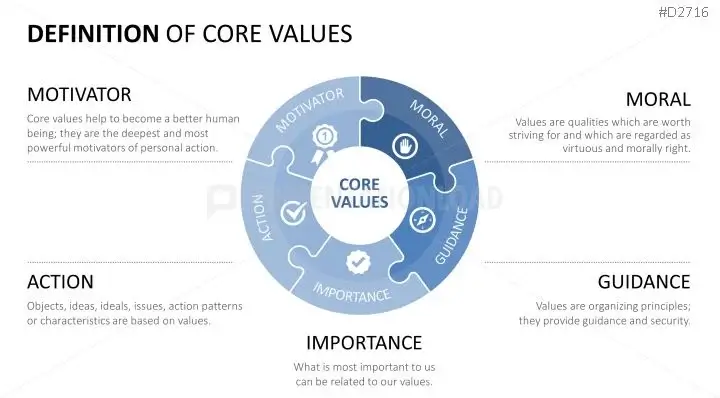เปิดเผยสูตรที่ซ่อนอยู่: ค้นพบว่าค่านิยมหลักเป็นกุญแจสำคัญในการปลดล็อกความสำเร็จขององค์กรของคุณอย่างไร

สารบัญ
- ทำความเข้าใจเกี่ยวกับค่านิยมหลัก
- ขั้นตอนในการกำหนดค่านิยมหลัก
- การนำค่านิยมหลักไปปฏิบัติและฝังไว้
- การปลูกฝังและรักษาคุณค่าหลัก
- บทสรุป
ไม่ว่าจะมีขนาดหรืออยู่ในอุตสาหกรรมใด องค์กรทุกแห่งต่างก็ดำเนินงานโดยมีความเชื่อและหลักการร่วมกันที่กำหนดวัฒนธรรมและชี้นำกระบวนการตัดสินใจ องค์ประกอบพื้นฐานเหล่านี้ ซึ่งเรียกว่าค่านิยมหลัก จะเป็นเสมือนเข็มทิศสำหรับองค์กรต่างๆ ที่ชี้นำพวกเขาไปสู่พันธกิจและวิสัยทัศน์ การกำหนดค่านิยมหลักมีความสำคัญอย่างยิ่งในการสร้างวัฒนธรรมองค์กรที่แข็งแกร่งซึ่งส่งเสริมการทำงานร่วมกัน การมีส่วนร่วม และความสำเร็จในระยะยาว ในโพสต์บล็อกนี้ เราจะเจาะลึกกระบวนการกำหนดค่านิยมหลักและสำรวจว่าองค์กรต่างๆ สามารถสร้างค่านิยมหลักได้อย่างไร สภาพแวดล้อมที่ขับเคลื่อนด้วยคุณค่า.
ทำความเข้าใจเกี่ยวกับค่านิยมหลัก
ก่อนจะเริ่มดำเนินการใดๆ จำเป็นต้องเข้าใจแก่นแท้และความสำคัญของค่านิยมหลัก ค่านิยมหลักเป็นหลักการที่ฝังรากลึกซึ่งเป็นรากฐานของ เอกลักษณ์ขององค์กรไม่ควรสับสนระหว่างคำชี้แจงภารกิจและวิสัยทัศน์ ซึ่งระบุวัตถุประสงค์และความปรารถนาขององค์กร ในทางกลับกัน ค่านิยมหลักจะกำหนดมาตรฐานพฤติกรรมและความเชื่อที่ชี้นำการกระทำและการตัดสินใจขององค์กร
ค่านิยมหลักเป็นเครื่องมือที่มีประสิทธิภาพที่มีอิทธิพลต่อวัฒนธรรมองค์กร องค์กรต่างๆ สร้างความรู้สึกถึงเอกลักษณ์และทิศทาง โดยการกำหนดและยึดถือค่านิยมหลัก และสร้างกรอบการทำงานสำหรับพนักงานเพื่อปรับการกระทำของตนให้สอดคล้องกับวัตถุประสงค์ของบริษัท ค่านิยมร่วมเหล่านี้จะกำหนดวิธีที่พนักงานโต้ตอบ รับมือกับความท้าทาย และท้ายที่สุดคือความสำเร็จขององค์กร
ขั้นตอนในการกำหนดค่านิยมหลัก
การกำหนดค่านิยมหลักเป็นกระบวนการที่รอบคอบและครอบคลุมซึ่งเกี่ยวข้องกับผู้มีส่วนได้ส่วนเสียต่างๆ เพื่อให้แน่ใจว่าค่านิยมที่ระบุจะสะท้อนถึงทั่วทั้งองค์กร มาสำรวจขั้นตอนสำคัญที่องค์กรสามารถปฏิบัติตามเมื่อกำหนดค่านิยมหลักกัน
การรวบรวมข้อมูลจากผู้มีส่วนได้ส่วนเสีย
การมีส่วนร่วมของพนักงาน ผู้บริหาร และผู้มีส่วนได้ส่วนเสียหลักในการกำหนดค่านิยมหลักนั้นถือเป็นสิ่งสำคัญ ขั้นตอนแรกคือรวบรวมข้อมูลจากพวกเขาผ่านแบบสำรวจ สัมภาษณ์ กลุ่มเป้าหมาย หรือการประชุมในศาลากลาง วิธีนี้จะช่วยให้สามารถ ความเข้าใจที่ลึกซึ้งยิ่งขึ้นเกี่ยวกับวัฒนธรรมขององค์กรค่านิยม และแรงบันดาลใจจากมุมมองที่แตกต่างกัน การมีส่วนร่วมของผู้มีส่วนได้ส่วนเสียที่หลากหลายทำให้องค์กรสามารถส่งเสริมความครอบคลุมและมั่นใจได้ว่าค่านิยมหลักสะท้อนถึงเอกลักษณ์ส่วนรวมขององค์กร
การประเมินวัฒนธรรมและค่านิยมที่มีอยู่
การประเมินวัฒนธรรมและค่านิยมที่มีอยู่นั้นถือเป็นสิ่งสำคัญในการสร้างชุดค่านิยมหลักที่แสดงถึงองค์กรอย่างแท้จริง ซึ่งเกี่ยวข้องกับการวิเคราะห์ประวัติ บรรทัดฐาน ความสำเร็จ และความล้มเหลวขององค์กร โดยการไตร่ตรองถึงจุดแข็งและจุดอ่อนของวัฒนธรรมปัจจุบัน องค์กรสามารถระบุพื้นที่ในการปรับปรุงและพื้นที่ที่จะพัฒนาได้ การทำความเข้าใจวัฒนธรรมที่มีอยู่นั้นจะช่วยให้มีบริบทที่จำเป็นในการกำหนดค่านิยมหลักที่แท้จริงและเกี่ยวข้อง
การกำหนดรายการค่านิยมหลักที่มีศักยภาพ
ในขั้นตอนนี้ องค์กรต่างๆ อำนวยความสะดวก การระดมความคิด การประชุมเชิงปฏิบัติการ หรือการฝึกฝนเพื่อสร้างฉันทามติอื่นๆ เพื่อสร้างรายการค่านิยมหลักที่เป็นไปได้ การประชุมเหล่านี้ช่วยให้ผู้มีส่วนได้ส่วนเสียสามารถเสนอแนวคิดและข้อเสนอแนะของตนเองได้ สิ่งสำคัญคือต้องให้ความสำคัญกับค่านิยมที่สอดคล้องกับเป้าหมายและความปรารถนาขององค์กรอย่างใกล้ชิด องค์กรต่างๆ ส่งเสริมความรู้สึกเป็นเจ้าของและมุ่งมั่นโดยให้ผู้มีส่วนได้ส่วนเสียมีส่วนร่วมในกระบวนการนี้
การจำกัดขอบเขตและการปรับแต่งค่านิยมหลัก
องค์กรต่างๆ ต้องประเมินและปรับปรุงค่านิยมหลักที่มีอยู่เพื่อให้เกิดประสิทธิผลและความถูกต้อง โดยต้องประเมินความชัดเจน ความเกี่ยวข้อง และผลกระทบที่อาจเกิดขึ้นของค่านิยมแต่ละค่าที่มีต่อวัฒนธรรมขององค์กร เป้าหมายคือการระบุค่านิยมหลักที่กระชับ เข้าใจง่าย และสามารถสร้างแรงบันดาลใจให้กับพนักงานได้ การแสวงหาความสอดคล้องและการยอมรับสูงสุดจากผู้มีส่วนได้ส่วนเสียจะช่วยให้มั่นใจได้ว่าค่านิยมหลักที่เลือกไว้จะสะท้อนถึงองค์กรได้
การกำหนดและสื่อสารค่านิยมหลัก
เมื่อกำหนดค่านิยมหลักได้แล้ว การเขียนคำชี้แจงค่านิยมที่กระชับและสร้างแรงบันดาลใจจึงมีความจำเป็น คำชี้แจงเหล่านี้ควรสรุปสาระสำคัญของค่านิยมแต่ละประการ ทำให้พนักงานทุกคนสามารถเชื่อมโยงและดำเนินการได้ การสื่อสารคุณค่าหลักอย่างมีประสิทธิผล ถือเป็นกุญแจสำคัญในการสร้างความเข้าใจและความมุ่งมั่นร่วมกันทั่วทั้งองค์กร องค์กรต่างๆ สามารถใช้ช่องทางการสื่อสารต่างๆ เช่น แคมเปญภายใน จดหมายข่าว และการประชุมทีม เพื่อแบ่งปันและเสริมสร้างค่านิยมหลัก
“ค้นพบพลังของการกำหนดค่านิยมหลักที่ชี้นำการเดินทางสู่ความสำเร็จขององค์กรของคุณ เปิดเผยความลับและสร้างรากฐานที่ยั่งยืนที่สร้างแรงบันดาลใจให้เกิดความยิ่งใหญ่! #CoreValues #Success #Inspiration”
การนำค่านิยมหลักไปปฏิบัติและฝังไว้
การกำหนดคุณค่าหลักเพียงอย่างเดียวไม่เพียงพอ องค์กรต่างๆ ต้องปฏิบัติตามที่พูดไว้และบูรณาการคุณค่าเหล่านั้นเข้ากับระบบ แนวทางปฏิบัติ และการดำเนินงานประจำวัน มาสำรวจขั้นตอนสำคัญบางประการในการนำคุณค่าหลักไปปฏิบัติและฝังไว้ในองค์กรกัน
บทบาทของผู้นำในการปลูกฝังค่านิยมหลัก
ความเป็นผู้นำมีความสำคัญอย่างยิ่งในการทำให้มั่นใจว่าค่านิยมหลักขององค์กรได้รับการปลูกฝังและดำเนินชีวิตตาม ผู้นำต้องเป็นผู้นำโดยการเป็นตัวอย่าง โดยยึดถือค่านิยมหลักในการกระทำและการตัดสินใจ พฤติกรรมของพวกเขาควรเสริมสร้างวัฒนธรรมที่ต้องการ และพวกเขาต้องรับผิดชอบต่อการยึดมั่นในค่านิยมหลัก เมื่อผู้นำนำค่านิยมหลักมาใช้กับแนวทางการเป็นผู้นำ ก็จะเกิดผลกระทบตามมาและสร้างแรงบันดาลใจให้พนักงานทำเช่นเดียวกัน
การบูรณาการค่านิยมหลักเข้ากับระบบและแนวทางปฏิบัติขององค์กร
เพื่อฝังค่านิยมหลักอย่างแท้จริงลงในโครงสร้างขององค์กร จำเป็นต้องบูรณาการค่านิยมเหล่านี้เข้ากับระบบและแนวทางปฏิบัติต่างๆ ทรัพยากรบุคคล กระบวนการ นโยบาย และขั้นตอนต่างๆ ควรสอดคล้องกับค่านิยมหลัก ตัวอย่างเช่น ค่านิยมหลักสามารถนำมาพิจารณาในระหว่างกระบวนการจ้างงาน เพื่อให้แน่ใจว่าผู้สมัครและองค์กรมีความเหมาะสมทางวัฒนธรรม การประเมินผลการปฏิบัติงานและโปรแกรมการรับรู้ควรสะท้อนและให้รางวัลแก่พฤติกรรมที่สอดคล้องกับค่านิยมหลัก การบูรณาการนี้จะทำให้วัฒนธรรมที่ขับเคลื่อนด้วยค่านิยมแข็งแกร่งขึ้น และกระตุ้นให้พนักงานยึดถือและนำค่านิยมหลักไปใช้ในการทำงานประจำวัน
การสื่อสารค่านิยมหลักภายในและภายนอก
การสื่อสารภายในและภายนอกทำหน้าที่เป็นกลไกในการ การเสริมสร้างค่านิยมหลักและแสดงความมุ่งมั่นขององค์กรภายในองค์กรสามารถพัฒนาแคมเปญ จดหมายข่าว และโปรแกรมการฝึกอบรมเพื่อเตือนพนักงานให้ตระหนักถึงค่านิยมหลักและความสำคัญของค่านิยมดังกล่าวอย่างต่อเนื่อง ภายนอกองค์กรสามารถนำค่านิยมหลักไปผนวกเข้ากับกลยุทธ์การตลาดและการสร้างแบรนด์ได้ เพื่อสร้างความโปร่งใสและดึงดูดลูกค้าและพันธมิตรที่มีแนวคิดเดียวกัน การสื่อสารอย่างมีประสิทธิผล ของค่านิยมหลักสร้างข้อความที่สอดคล้องกันและช่วยให้องค์กรสร้างชื่อเสียงบนพื้นฐานของความไว้วางใจและความถูกต้อง
การปลูกฝังและรักษาคุณค่าหลัก
ค่านิยมหลักไม่ใช่สิ่งที่หยุดนิ่ง แต่ควรพัฒนาและปรับตัวตามการเติบโตและการเปลี่ยนแปลงขององค์กร องค์กรต่างๆ ต้องใช้แนวทางที่ต่อเนื่องและต่อเนื่องเพื่อรักษาและรักษาค่านิยมหลักไว้
การประเมินและทบทวนค่านิยมหลักเป็นระยะๆ
องค์กรต่างๆ ควรประเมินและประเมินค่านิยมหลักของตนเป็นระยะๆ เพื่อให้ยังคงมีความเกี่ยวข้องและสอดคล้องกับบริบทที่เปลี่ยนแปลงไป การประเมินผลกระทบและประสิทธิภาพของค่านิยมหลัก ค่านิยม ช่วยให้องค์กรสามารถระบุพื้นที่ที่ต้องปรับปรุงและปรับใช้ตามความจำเป็น แนวทางแบบวนซ้ำนี้ช่วยให้มั่นใจว่าค่านิยมหลักยังคงมีความสำคัญต่อการกำหนดวัฒนธรรมขององค์กรและขับเคลื่อนความสำเร็จที่ยั่งยืน
ส่งเสริมการจัดแนวอย่างต่อเนื่องกับค่านิยมหลัก
องค์กรควรจัดให้มีโอกาสอย่างต่อเนื่องสำหรับพนักงานในการปรับพฤติกรรมให้สอดคล้องกับค่านิยมหลัก ซึ่งรวมถึงการจัดโปรแกรมการฝึกอบรมและการพัฒนาที่เสริมสร้างค่านิยมหลัก การส่งเสริมวัฒนธรรมการตอบรับที่ดีช่วยให้พนักงานสามารถระบุความไม่สอดคล้องระหว่างพฤติกรรมและค่านิยมหลักได้ ทำให้สามารถแก้ไขแนวทางได้ทันท่วงที การส่งเสริมการจัดแนวอย่างต่อเนื่ององค์กรต่างๆ จะต้องสร้างความมั่นใจว่าค่านิยมหลักยังคงดำรงอยู่และมีอิทธิพลต่อทุกระดับขององค์กร
บทสรุป
การกำหนดค่านิยมหลักถือเป็นขั้นตอนพื้นฐานในการสร้างองค์กรที่ขับเคลื่อนด้วยค่านิยม องค์กรสามารถสร้างรากฐานที่แข็งแกร่งสำหรับความสำเร็จได้โดยการมีส่วนร่วมของผู้มีส่วนได้ส่วนเสีย การประเมินวัฒนธรรมที่มีอยู่ และการระบุค่านิยมหลักในลักษณะที่มีความหมายและเชื่อมโยงกันได้ การนำค่านิยมหลักเหล่านี้ไปใช้และฝังไว้ในระบบ แนวทางปฏิบัติ และช่องทางการสื่อสารต่างๆ ขององค์กรถือเป็นสิ่งสำคัญเพื่อให้แน่ใจว่าค่านิยมเหล่านี้มีประสิทธิผล องค์กรสามารถสร้างวัฒนธรรมที่มีชีวิตชีวาซึ่งสร้างแรงบันดาลใจให้กับพนักงานและขับเคลื่อนความสำเร็จในระยะยาวได้ด้วยการปลูกฝังและปรับให้สอดคล้องกับค่านิยมหลักอย่างต่อเนื่อง
